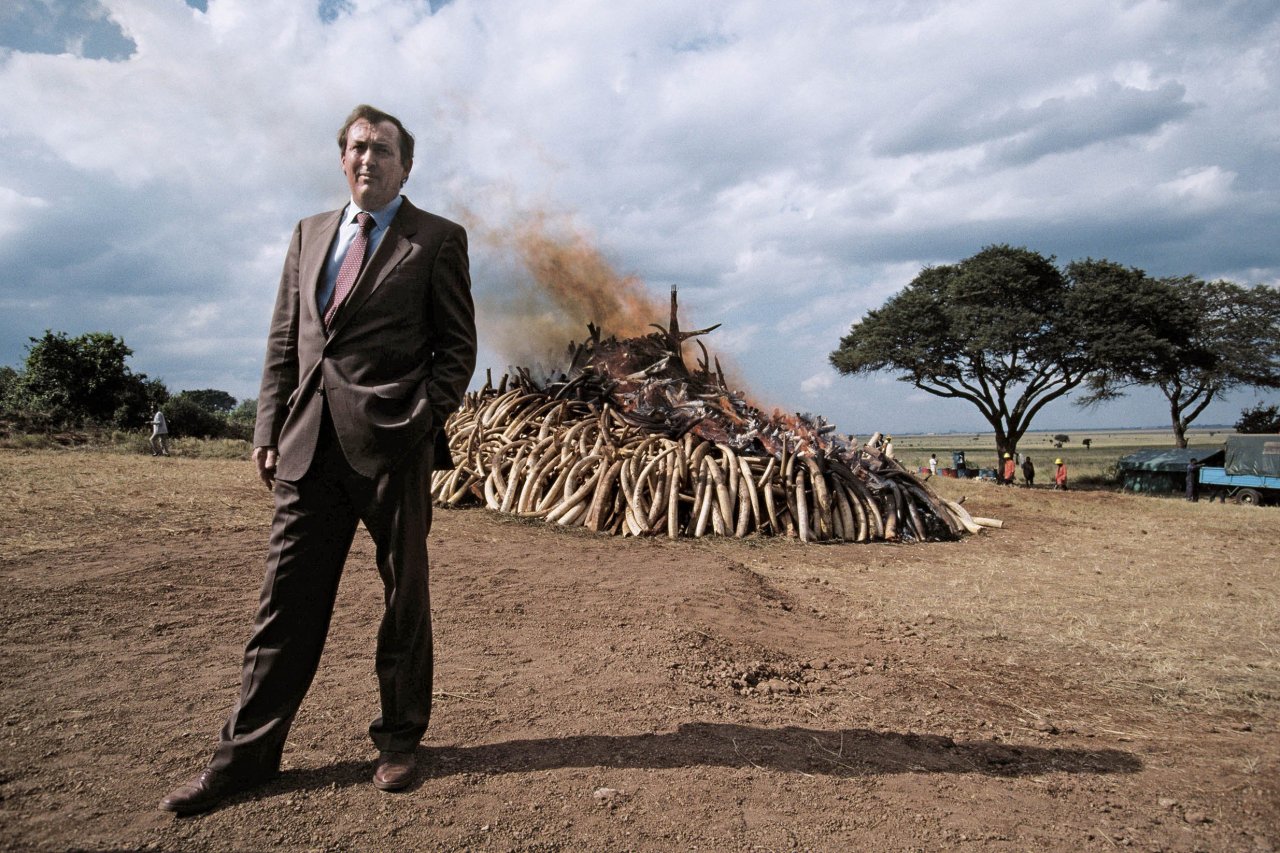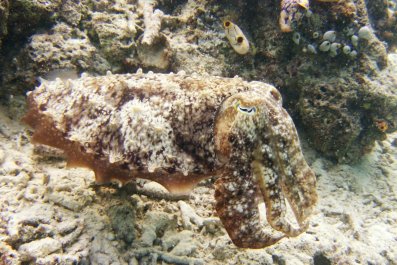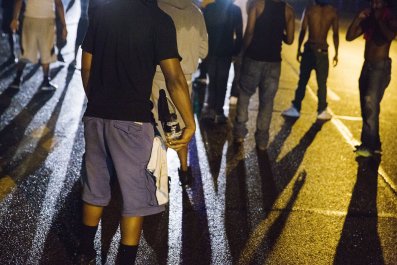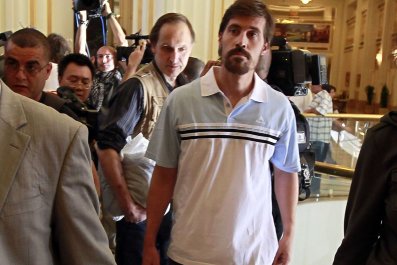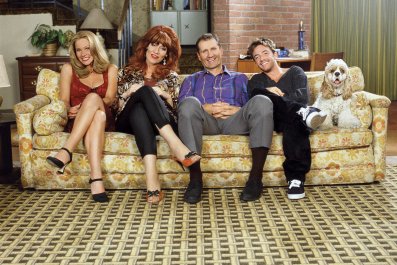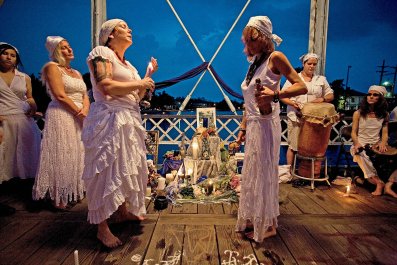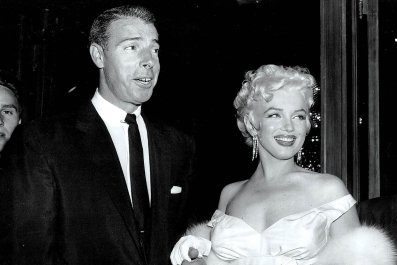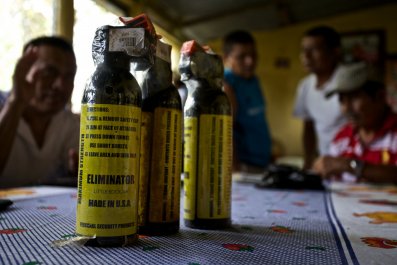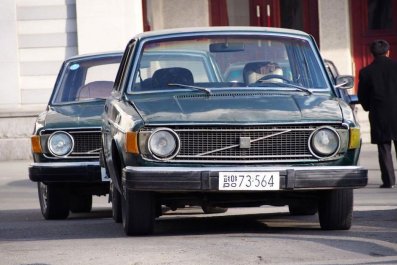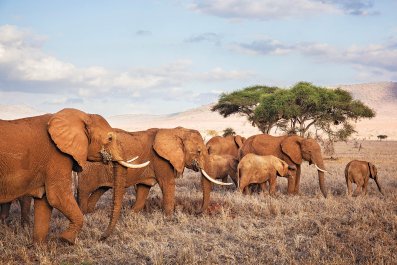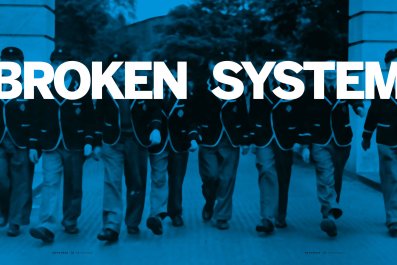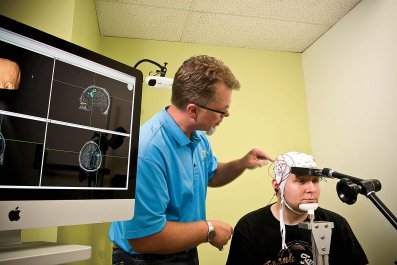Richard Leakey has returned to the Masai Mara, and one of the first social calls he makes is to the local Maasai elders. He says it is traditional in African society that if a known elder – the Swahili word is mzee – travels into other elders' territory, he should meet with them.
"When I ran [the Kenyan Wildlife Service] I had a reputation for being on the side of the Maasai, so they know me well," he says. "When we arrived this morning, word went out that I was here."
The Maasai elders are clearly delighted to see mzee. They gather around him and for the next 10 minutes there is an exuberant exchange in Swahili, with Leakey telling them that he understands they have great challenges but that he appreciates what they were doing, and that the protection of wildlife is important for the nation. This meeting also serves as a reminder that Leakey is anything but a mzungu (a white man) but rather, as he claims, a true African.
When we get back to camp Leakey arranges to buy a goat and have it sent to the Maasai elders so they will have a feast that night.
Best known for digging up skulls that shed light on humanity's origins, Leakey is back to pursuing the other great passion of his life – saving elephants and other endangered species threatened by poachers. The 69-year-old has made this trip with his protégé, Dr Paula Kahumbu, who now heads up Wildlife Direct, the activist organisation he founded in 2006.
This is Leakey's third, fourth, or even fifth coming, depending on how you measure these things, and it is certainly a remarkable comeback. Last September he had a liver transplant in New York's Mount Sinai Hospital and by all accounts was very close to death. He has already endured two kidney transplants, one in 1980 and the second in 2006, and he lost both his legs in a light aircraft accident in 1993 that he is convinced was an assassination attempt in retaliation for his conservation work.

Leakey warns Kahumbu that she should be careful and think seriously about employing a bodyguard. "When I was head of the Kenya Wildlife Service I had five bodyguards, night and day, 24/7," he says, "And I needed them. There were many, shall we say, interesting incidents."
That Leakey is back on the antipoaching campaign trail is good news for African conservationists. When he last rode to the rescue 25 years ago, appointed by the then Kenyan President Daniel arap Moi to be the head of a bankrupt, corrupt and incompetent Wildlife and Conservation Department, Leakey stopped a tidal wave of poaching.
He turned the department, which was renamed the Kenya Wildlife Service (KWS), into a paramilitary organisation that had presidential permission to shoot poachers on sight
One conservationist said, "If Richard Leakey hadn't been around then we'd have probably lost our wildlife by now."
Now the wildlife of Kenya, indeed of the entire African continent, is in crisis again. It is threatened by a combination of growing demand for ivory and rhino horn in the Far East, increased activity from Al-Shabaab terrorists and Somali criminal gangs, and endemic corruption in the wildlife services. The soaring value of wildlife products has driven this latest poaching pandemic – in the Far East a single elephant's tusks that weighs 10kg will fetch more than $30,000, while rhino horn is selling at $65,000 a kilogram, more than twice the price of gold.
In August, it was announced that a tipping point had been reached: more African elephants are being killed each year than are being born.
Their end is in sight. Research published in the Proceedings of the National Academy of Sciences found that between 2010 and 2013, Africa lost an average of 7% of its elephant population each year; at this rate, the animals could be wiped out in 100 years.
According to the KWS, last year Kenya lost 59 rhinos, a significant number because the entire population numbers only around 1,000.
Also, according to KWS, 300 elephants were poached last year, a figure that draws snorts of derision from Leakey. "They're lying," he says. "We think it is ten times that number."
There are now more than 30,000 African elephants a year being poached for their ivory, according to conservation groups, and in South Africa, which has more than 85% of the continent's remaining rhino, they are losing a rhino every 8 hours to poachers. Lion populations are also threatened, with five lions a day being killed illegally. At this rate these signature species will no longer exist in the wild within a generation or two.
"My Elephants, My Heritage"
"I hope we're not just going to talk about endangered wildlife," Leakey says grumpily as he heaves himself up onto his prosthetic legs and clambers down from the Cessna Caravan onto the dirt landing strip below. "I have been doing a bit more than that, you know."
It is a typically contrarian remark that belies the work he and Kahumbu have been doing.
Most recently, they made news by accusing the Kenyan government of protecting international poaching networks. Leakey levelled these accusations after one of Kenya's last big tuskers, the magnificent 45-year-old Satao, was found dead in Tsavo National Park with its enormous tusks hacked off and presumably already smuggled out of the country. He said there was "no question that there's very high level protection of individuals who engage in the illegal export of elephant ivory and rhino horn."
Associates of a well-known Kenyan businessman, Feisal Mohamed Ali, were arrested in June in Mombasa with some 228 tusks and 74 ivory pieces weighing some 2,100kg.
Although a warrant was issued for Feisal's arrest, he remains free. Leakey and Kahumbu cite this as an example of high level protection and Kahumbu says, "There are probably another 10 Feisels operating in Kenya right now."
Such accusations of corruption directed at African administrations and their business connections frequently invite serious trouble, as Leakey knows from his experience. Although Leakey has now formally handed over the reins of Wildlife Direct to the feisty, articulate Kahumbu, he is very much the strategic driving force behind this small NGO that has already had an impact.
The group has been instrumental in the introduction of dramatic laws for wildlife trafficking offences that increased penalties for possession of ivory or rhino horn from 40,000 to 20 million Kenyan shillings ($230,000), the most severe on the continent.
It also helped force the government to ban the use of Furadan, an insecticide used by farmers that has over the past years been responsible for the poisoning of hundreds of lions, hyenas, vultures and other animals. And it has successfully pressured the courts to stop the government from going ahead with a Chinesebuilt, four-lane highway through Nairobi National Park, the country's oldest wildlife reserve.
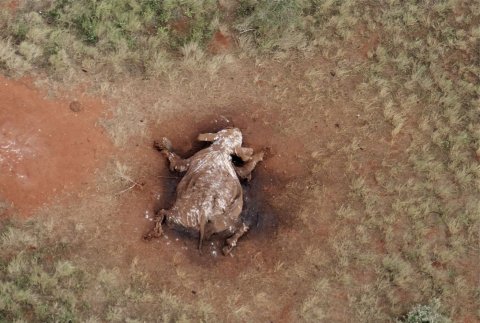
Perhaps most importantly, Leakey and Kahumbu have, through the use of social media, engaged their fellow Kenyans in citizen conservation. Kahumbu says there is now an unprecedented groundswell of "citizen concern", a significant shift in public engagement. The slogan "My elephants, my heritage" is constantly retweeted because "elephants are part of our heritage," she says.
Kahumbu adds that while white conservationists have sometimes dominated the African wildlife theatre and propagated the view that black Africans are uninterested in their wild animals, "Our social media traffic completely undermines that stereotyping."
Leakey cites recent evidence of corruption within the KWS – six senior deputy directors were recently suspended and more than 30 KWS rangers have also been suspended – as reason to radically reform the organisation at the heart of Kenyan anti-poaching operations. He has also made a formal request to President Uhuru Kenyatta to declare a state of national emergency on wildlife poaching. At the time of writing the president has not responded.
A Stronger Juju
Leakey's life has from the outset been a stormy brew of successes, controversies, bitter fights with numerous enemies and dreadful misfortunes – a wild postcolonial adventure. Amid the internecine wars, economic catastrophes, tribalism and corruption of modern Africa, he has been one of the few white men to have muscled his way to the top and become a major African figure. Significantly, he does not see himself as a white man in Africa, but simply an African.
The second of three sons born to the famous palaeontologists Louis and Mary Leakey, Richard grew up in 1950s Kenya and witnessed the country's metamorphosis from jewel of the British Empire and playground for European aristocrats to independence and black majority rule. By the time he left school in 1960, the old Kenya of Karen Blixen and Denys Finch Hatton existed only in memory and in its place was a sociopolitical order that had no place for the sons and daughters of white colonials.
Despite a dismal academic record – he left school at 16 with modest exam results – he has achieved world renown as a paleoanthropologist, has a string of honorary doctorates and has been elected a Fellow of the Royal Society. He has also written several books on the origins of man and counts celebrities and royalty among his friends.
He says his avowed intention had been to keep out of the family business; however the young Leakey soon capitulated and began leading fossil-hunting expeditions to Koobi Fora on the shores of Lake Turkana. In 1969 and again in 1972 his teams at Koobi Fora made fossil discoveries that would establish him as something of a cult figure.
The second find uncovered Skull 1470, the two-million-year-old Homo habilis that was to make his name and propel him onto the cover of Time magazine. The pop paleo had arrived. For all that, Leakey was coldly received by the scientific establishment. After his presentation of 1470 to the Zoological Society of London, the Secretary, Lord Zuckerman, responded caustically: "May I first congratulate Mr Leakey, an amateur and not a specialist, for the very modest and moderated way he gave his presentation."
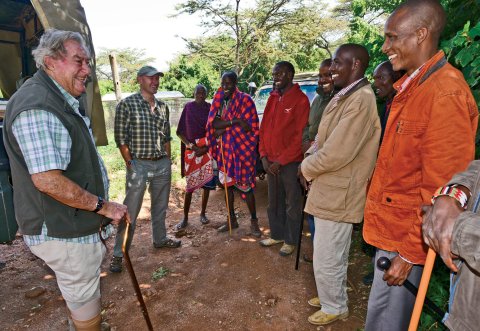
Although clearly stung by the scientific establishment's rejection, Leakey forged ahead as he always did, and in 1977 published Origins, a bestseller that popularised paleoanthropology and made him even more of a household name. Two years later, while he was preparing The Making of Mankind, the BBC's megadocumentary on human evolution, he became seriously ill. His blood pressure was stratospherically high, he was vomiting four or five times a day and struggling to keep up with his work schedules.
At the time, in his parallel role as Director of the National Museums of Kenya, he was having terrible problems with his staff. He remembers that there was "an unfortunate undercurrent of hatred and bitterness in the museum . . . and some of the staff thought that my hospitalization was due to a spell successfully cast by one of my enemies. Indeed, one of my more senior colleagues, a person who had received a PhD in the USA, had openly boasted that my illness was due to his strong juju."
It was not juju. It was kidney failure. And in August 1980 Leakey had his first transplant. It was the first of several confrontations with mortality – all of which Leakey has shaken off with cavalier disdain.
A plane crash in 1993 very nearly killed him. He was flying four passengers up to Naivasha when, soon after takeoff from Nairobi's Wilson Airport, the engine in his Cessna 206 simply cut out. The plane plunged earthward and after rocketing over villages and schools he managed to drop it into a field. As it bounced across the uneven turf, the plane pulled left, a wing snagged on a tree, the fuselage somersaulted, and then ploughed nose first into the muddy earth. Leakey was the most seriously injured, the engine driving into his legs and snapping them like twigs.
He was evacuated to Nairobi, where an elderly British orthopedic surgeon fought to stave off septicaemia. For 12 terrible days Leakey refused to be transferred to a hospital in Europe or America, determined to keep his hand on the tiller of the KWS from his hospital bed. Finally, he was persuaded to seek a second opinion and trauma specialist Christopher Colton flew to Nairobi. When he arrived at the hospital, Colton later said, "I could smell the infection from the end of the corridor. Richard was dying."
Colton decided to fly Leakey to Britain the next day. Turning down the offer of a private jet, Leakey was loaded onto a British Airways flight "right at the back in economy class among the smokers because they could only get the stretcher in at the back."
A series of operations and bone grafts followed but failed to solve the problem and Colton amputated his left leg below the knee. Six months later the right leg followed.
According to his old friend, Georgiana Bronfman, it was Leakey himself who decided on the second amputation because he couldn't be bothered with a timeconsuming rehabilitation programme. She says, "Richard's attitude was, Take off the leg and let me get on with my work."
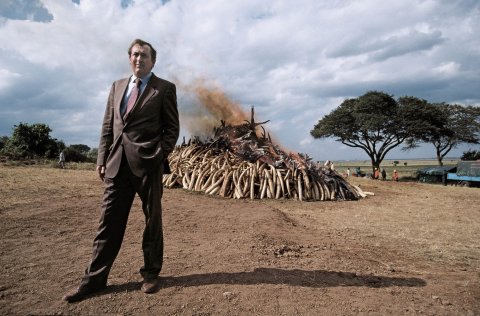
After the crash, Leakey told me, he was going to bury his legs at Lake Turkana, the site of many of the Leakey family's most important paleontology finds. Then he changed his mind and buried them at his home in the Ngong Hills, fearing that if they had been left in such a public place as Turkana his enemies might "urinate on them".
The scars of his many medical adversities are plainly visible. Once a handsome man – and rather famously a dashing ladies man – his face is now cratered with open sores and solar keratoses that are, he says, "a result of 40 years of taking immunosuppressant drugs".
Leakey, however, is entirely uninterested in his physical appearance and unselfconscious about his amputated legs, wearing shorts throughout our stay in the bush, proudly displaying his $20,000 prosthetic extensions.
A Macabre Sculpture
We are staying at a small luxury safari camp on the fringes of the Masai Mara reserve called Cottar's 1920s Camp. We decide to take a drive onto the Mara plains to look at the animals we have been discussing. Leakey and I agree that one of life's great pleasures is to head into the African bush and spend a day just sitting out there in silence watching the natural world unfold.
As we watch a group of vultures circling above us, floating effortlessly on the thermals, the conversation turns to his political enemies and how at the height of his success at the Kenya Wildlife Service there were people, even in government, who wanted him dead.

At that time, in the 1980s, Africa, and East Africa in particular, was suffering from a wave of poaching even more intense than it is today. In a matter of years its elephant population had fallen from 100,000 to 20,000, rhinos had been poached almost to extinction and, lions, cheetah and leopards were following not far behind. The country's wildlife was being wiped out.
The Leakey clean up was not to every Kenyan politician's taste – many were even then believed to be significant beneficiaries of the illicit wildlife trade. But Leakey had such standing in the international community as an incorruptible and effective operator that he was able to cajole international donors led by the World Bank into giving him $150m for a five-year conservation program with the promise of a further $150m after that.
When he'd arrived in the job he had admitted he knew little about wildlife conservation but that didn't stop him taking a vehement stand on how to save the African elephant. Ban the ivory trade and put the elephants behind fences, he said, protecting them with the help of large sums of foreign aid.
His opponents mainly from southern African countries argued that the ban would be counter-productive and that they were trying to tear down the fences and provide rural communities with incentives to live alongside the wild animals. Essential to these programmes was the revenue that came from selling ivory of culled elephants legally on the world markets.
Leakey knew very well that the Western donor community would not endorse culling – the controlled killing of elephants. Instead, he told the world's press, population levels would be controlled by providing female elephants with contraceptive rings. The roar of laughter from the wildlife community could be heard the entire length of the Rift Valley.
In 1989, the world ban on ivory trade was formalised and Leakey staged an event in Nairobi National Park that is still spoken of today. With the world press in attendance – and a live feed to the American television network show Good Morning America, 12 tons of elephant tusks from the KWS storerooms were arranged in what Leakey called "a macabre sculpture" and ceremonially set alight by President Moi.
"We Are All the African Diaspora"
Now, a quarter century later, at Cottar's Camp in the Mara, we are still debating the future of Africa's wildlife – but not just that. Leakey starts explaining the two projects that are closest to his heart right now. Predictably, they are both wildly, stratospherically ambitious schemes that would challenge an entrepreneur in his prime never mind a 69-year-old double amputee with a history of organ transplants.
The first is to create a Science Park at Lake Turkana that will tell the story of humankind. "We are all the African diaspora," he says, "We are proud to be the home of mankind, so this science park will be a celebration of mankind. I want this to be a free-standing monument to humanity." He says he negotiated a 5,000 hectare plot with the Turkana people and has the first $10m commitment from a single donor. When I say the project may take 10 or 20 years to complete, he responds impatiently: "Yes. So what."
The second is even more ambitious. For years the Tanzanian government has been threatening to build a highway through the Serengeti National Park, its greatest wilderness area and a World Heritage Site. While conservationists the world over have been throwing up their arms in collective horror, arguing that it would disrupt the wildebeest migration into Kenya, the ever pragmatic and imaginative Leakey came up with a plan. "I had no doubt that the Tanzanians would go ahead with this highway," he says, "whatever the outside world was saying."
Over dinner in New York he struck up conversation with Daniel Libeskind, the architect responsible for New York's One World Trade Centre, and they hatched a plot for an elevated highway that would swoop above the Serengeti, allowing the migrating animals to pass unhindered below. Leakey shows me Libeskind's diagrams and it looks to be a spectacular project. His illness put the project on the back burner but he says now that he has recovered he feels he should pursue it.
"This is even more ambitious than the Science Park and maybe it is too fantastic to absorb, maybe . . . "
And he leaves it hanging. It is the first time Richard Leakey has shown intimations of mortality.



